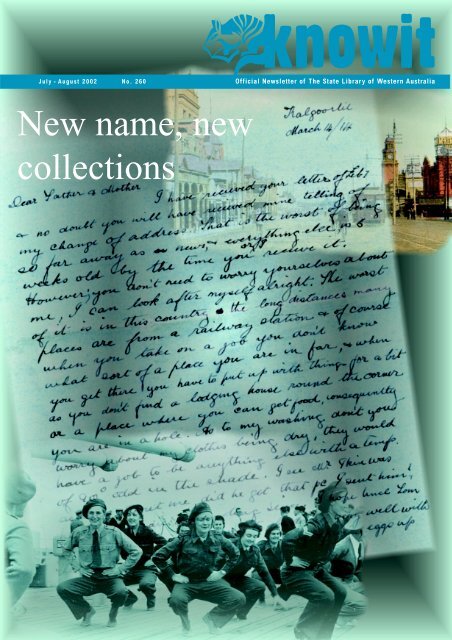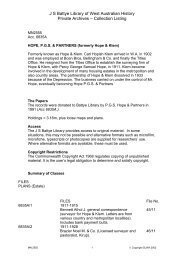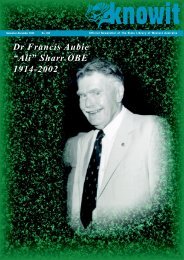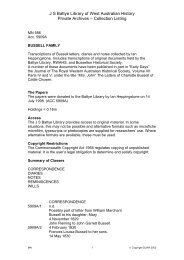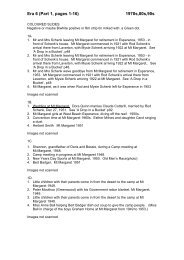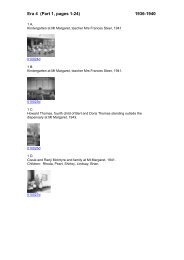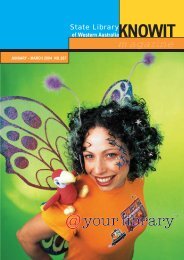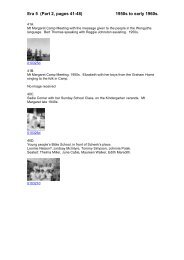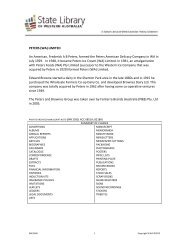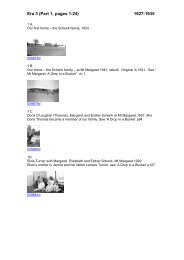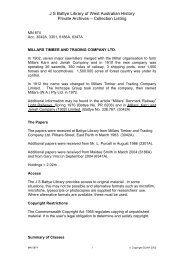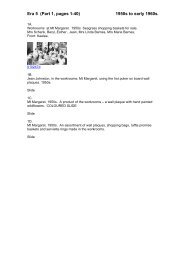july-aug 2002 - State Library of Western Australia
july-aug 2002 - State Library of Western Australia
july-aug 2002 - State Library of Western Australia
You also want an ePaper? Increase the reach of your titles
YUMPU automatically turns print PDFs into web optimized ePapers that Google loves.
1New name, newcollections
A FROM CLAIREWe’ve had an excitingstart to the newfinancial year, with anew name - <strong>State</strong><strong>Library</strong> <strong>of</strong> <strong>Western</strong><strong>Australia</strong> - and anumber <strong>of</strong> importantadditions to ourcollections. I would likeClaire Forte (Acting CEOand <strong>State</strong> Librarian) to acknowledge thework <strong>of</strong> the WA <strong>State</strong><strong>Library</strong> Custodians, as well as staff <strong>of</strong> the <strong>State</strong><strong>Library</strong>, for their work in orchestrating somesignificant donations to the JS Battye <strong>Library</strong>.In the last few months we have celebrated the handover<strong>of</strong> two very significant <strong>Western</strong> <strong>Australia</strong>ncollections - the Krantz and Sheldon collection <strong>of</strong>architectural plans and records, and the donationby ChevronTexaco, <strong>of</strong> the historical records fromWAPET. In each case it has been wonderful to meetthe donors and to hear them speak <strong>of</strong> the personalstories and important milestones in this <strong>State</strong>’shistory, that these historical records comprise.The new year heralds many challenges andopportunites for the <strong>State</strong> <strong>Library</strong>. There are anumber <strong>of</strong> significant projects underway and we lookforward to reporting on new collections, newinitiatives and service improvements in future issues.Commencing 1 July <strong>2002</strong>, The <strong>Library</strong> and InformationService <strong>of</strong> <strong>Western</strong> <strong>Australia</strong> (LISWA), has changedits name to <strong>State</strong> <strong>Library</strong> <strong>of</strong> <strong>Western</strong> <strong>Australia</strong>.Interestingly, the name <strong>State</strong> <strong>Library</strong> <strong>Western</strong><strong>Australia</strong> is not new. It was first used in 1955 whenthe newly formed <strong>Library</strong> Board <strong>of</strong> <strong>Western</strong> <strong>Australia</strong>was given control <strong>of</strong> the Public <strong>Library</strong> <strong>of</strong> <strong>Western</strong><strong>Australia</strong> (established as the Victoria Public <strong>Library</strong> in1887). The name The <strong>Library</strong> and Information Service<strong>of</strong> <strong>Western</strong> <strong>Australia</strong> (LISWA) was introduced as theoperational name <strong>of</strong> the organisation in 1989.Throughout our long history, we have continued tobuild collections and provide a range <strong>of</strong> informationand advisory services to the <strong>Western</strong> <strong>Australia</strong>ncommunity either directly, or through partnerships.Increasingly, we are utilising technologies to enablegreater access to collections and services. The name<strong>State</strong> <strong>Library</strong> <strong>Western</strong> <strong>Australia</strong> is one thatrecognises the important history <strong>of</strong> an old and reveredpublic institution, yet is one that will continue to beinstantly recognisable in future, aligning with all <strong>of</strong> theother <strong>State</strong> Libraries in <strong>Australia</strong>.The <strong>State</strong> <strong>Library</strong> <strong>of</strong> <strong>Western</strong> <strong>Australia</strong> is an agencywithin the Department <strong>of</strong> Culture & the Arts and ourhome base will continue to be the Alexander <strong>Library</strong>Building, located in the Perth Cultural Centre. Ourmailing address and all other contact details remainunchanged.2ISSN 1328-7176 Editorial Enquiries:Dana Tonello (Public Programs)ph:(08) 9427 3449 fax: (08) 9427 3152email: dtonello@liswa.wa.gov.auThe <strong>State</strong> <strong>Library</strong> <strong>of</strong> <strong>Western</strong> <strong>Australia</strong>Alexander <strong>Library</strong> Building, Perth Cultural Centre, Perth WA 6000Tel: (08) 9427 3111 Fax: (08) 9427 3256Website: www.liswa.wa.gov.auEditorial published may only be reproduced with the permission <strong>of</strong> Public Programs.Join The <strong>Western</strong> <strong>Australia</strong>n <strong>Library</strong> Society and you automatically receive knowit every two months.Membership enquiries (08) 9427 3150.Deadline for issue no. 261 (Sep - Oct ‘02) - 16 August <strong>2002</strong>knowit reserves the right to edit all articles. Views expressed do not necessarily reflect those <strong>of</strong> knowit orthe <strong>State</strong> <strong>Library</strong> <strong>of</strong> <strong>Western</strong> <strong>Australia</strong>. All articles must be supplied with a name and contact details forverification.COVER: A letter from the Frank Middleton collection (plus postcard picture <strong>of</strong> Kalgoorlie),and an image from Vicki Hobbs’ collection (BA1286.156). See page 3 for the Vicki Hobbsarticle and Page 4 for the story <strong>of</strong> Frank Middleton.
3Victoria Alexandra Hobbs OAM (Battye <strong>Library</strong>,BA 1286.42)In the busy corner <strong>of</strong> the PictorialCollection yet another selection <strong>of</strong>photographs has been accessionedready for use. These belonged toVictoria Alexandra May Hobbs (1907-1995).The photographs provide windows intothe various key aspects <strong>of</strong> VictoriaHobbs’ life – her nursing career in all itsfacets; her church, St Mary’s AnglicanChurch South Perth and her community<strong>of</strong> South Perth.However it was nursing which was herlife. As she once said, ‘When you’re anurse you’re in it for life.’ Victoria Hobbsgraduated from the School <strong>of</strong> Nursingat Perth Public Hospital in 1932 andfurthered her training at KEMH and thenmuch later in Canberra. She held theposition <strong>of</strong> Principal Tutor at the WAGovernment School <strong>of</strong> Nursing for 16years during which time she researchedand wrote the book But WestwardLook: Nursing in WA 1829-1979.‘When you’re a nurse, you’re in it for life’Victoria Alexandra May Hobbs OAMBlended into Vicki Hobbs’ nursing careerwas her World War 2 service. In 1940she enlisted in the <strong>Australia</strong>n ArmyNursing Service. Her tour <strong>of</strong> duty withthe 2/4th <strong>Australia</strong>n General Hospitalincluded places as far afield as Tobruk,the Middle East, Ceylon, Darwin andBorneo. She rose to the rank <strong>of</strong> Captain.There are many interesting photographsrelating to her war experiences includingworking conditions in hospital wards(many <strong>of</strong> which were tents or huts) inthe Middle East, Darwin and Borneo,shipboard activities on troop carriers,bomb damage in and a Japanese planeshot down over Darwin. Anotherphotograph <strong>of</strong> the staff at the LoneRange Weapons’ Testing Facility atWoomera shows the last appointmentin her military life when she wasresponsible for the health <strong>of</strong> both theservice personnel and civilians.In addition to these photographs areseveral unusual World War 1photographs. One example is thespectacular panoramic view <strong>of</strong> the tents<strong>of</strong> the 60th General Hospital at Salonika,which is historically <strong>of</strong> great value.The community <strong>of</strong> South Perth whereVictoria Hobbs grew up in a housebehind her father’s boot and shoe shopin Mend Street remained the other focus(1907 - 1995)<strong>of</strong> her life. Mends Street as she knew itis reflected in a series <strong>of</strong> photographstaken before the streetscape wasaltered. Another group <strong>of</strong> before andafter photographs <strong>of</strong> Gardiner StreetComo provides an image <strong>of</strong> herimmediate neighbourhood changingfrom single to multiple dwelling sites.Victoria Hobbs helped research thehistory <strong>of</strong> St Mary’s Anglican ChurchSouth Perth and Royal Perth Hospital.She also interviewed retired nurses andthen donated the tapes to the OralHistory Unit <strong>of</strong> Battye <strong>Library</strong>.Although this collection includes manyphotographs and slides as well as anassortment <strong>of</strong> invitations, articles andpostcards, there are very fewphotographs <strong>of</strong> Vicki Hobbs herself.Only one or two show her in civiliannursing sister’s uniform but the best isthe hand tinted portrait <strong>of</strong> her in<strong>Australia</strong>n Army Nursing Serviceuniform <strong>of</strong> cape and veil (pictured left).All the photographs have now beenlisted and described with many beingdigitised for online research. The entirecollection <strong>of</strong> 365 photographs reflectsVictoria Hobbs’ life <strong>of</strong> service anddedication.Linley BatterhamVolunteer, Battye <strong>Library</strong>Part <strong>of</strong> the collection consists <strong>of</strong> thephotographs used in her book includingseveral <strong>of</strong> early <strong>Western</strong> <strong>Australia</strong>nhospitals like Mary Nicolays’ PrivateHospital in Adelaide Terrace Perthdated 1898 and bird’s eye views intosome <strong>of</strong> the wards and the operatingtheatre <strong>of</strong> Perth Public Hospital 1920sand 30s.ABOVE: PT for women members <strong>of</strong> Victory Contingent en route to England aboard HMAS Shropshire,1946 (Battye <strong>Library</strong>, BA1286.156)
Letters home: The Frank Middleton Collection4In April <strong>2002</strong>, through the agency <strong>of</strong> SaraJoynes, the National <strong>Library</strong>’srepresentative at the <strong>Australia</strong>n HighCommission in London, the Battye <strong>Library</strong>received a folder <strong>of</strong> letters and postcardsfrom Arthur Lupton <strong>of</strong> North Yorkshiresimply entitled ‘Uncle Frank’.‘Uncle Frank’ was Frank Middleton, ayoung farmer from Tyldesley, England. Inpoor health, suffering with bronchitis, hetravelled to <strong>Western</strong> <strong>Australia</strong> where theclimate would supposedly be <strong>of</strong> benefit tohim. His letters document his travels s<strong>of</strong>ar from home.He wrote lovingly to his parents, andMargaret and James, his siblings,responding to their letters and gifts,sending his own. Through Frank’s writinghis family become real. He speaks <strong>of</strong> hiswish to work his own property rather thanlabour for a ‘cocky’, and describes in somedetail the society he sees around him, insome ways familiar but more <strong>of</strong>tendramatically different to the life he leftbehind. Frank regularly sent home a localpaper for his father, including the SundayTimes, and <strong>of</strong>ten included postcards orphotographs <strong>of</strong> himself with his lettersSailing from London, Frank disembarkedfrom the SS Orontes at Fremantle on 9December 1913 and, within a week,moved to Gingin where he worked for aman named Wake. A working day <strong>of</strong> 5amto 8pm left an impression:I hardly think I shall settle out here [WA],though they say a man has a chance <strong>of</strong>making his fortune in 10 years, but on theother hand it means you have to practicallyslave all the time, put up with a lot <strong>of</strong>hardship & 10 yrs exile. Is it worth it. [26December 1913]Experiencing difficulties with theenvironment, conditions, and Wakehimself, Frank headed to Coolgardie andKalgoorlie in late January. During hissojourn in the Goldfields he befriendedanother young chap, fresh out fromEngland like himself, W (William) EGratton.Frank’s impressions <strong>of</strong> the Goldfields arestill familiar to travellers today:Talk about pubs, it is no use sending a manout here to break him <strong>of</strong>f the drink, theyare all over the shop. Every little place, ifit has only ½ doz shanties, has a pub.Hannan St, in this place … contains 24…[14 Feb 1914, Kalgoorlie]I confine myself to as few changes <strong>of</strong>clothes as possible while up here, as it isso dusty & one has a job to keep anythingrealy [sic] clean my pants have a quite aredish [sic] tinge about them … it is quiteimpossible to get your handkerchiefs whiteowing to the water having a redish [sic]look about it. [14 March 1914, Kalgoorlie]And, <strong>of</strong> course, what young man couldignore the beauty <strong>of</strong> the strange new worldFrank found himself in:We get some startling modes <strong>of</strong> dressamong the woemen [sic] here, spilt skirtswith a rather large amount <strong>of</strong> leg shown(up to the knees), diaphanous dresses, etc& I only wrote you that dicription [sic] togive you some idea <strong>of</strong> things feminine outhere. I assure you I don’t go in for any‘picking up tricks’, too expensive I believe… [Short, undated letter to Margaret,Kalgoorlie]He noted the tough life on the land but alsothe contrast between country andtown.Some <strong>of</strong> these cockies areregular slave drivers. This issupposed to be a democraticcountry & is so to a great extentin the country but in the townsthere is any amount <strong>of</strong>snobbishness or rather swankseems the better word among thenouveau riche, just look at the societycolumns <strong>of</strong> the papers I am sending.[undated, before March 1914]After a period <strong>of</strong> restlessness, Frankapplied for, and was accepted into, theAgricultural College at Narrogin in April1914. There had initially been some doubtabout his acceptance, due to his age andhealth. The doctor in Kalgoorlie suspectedhe had tuberculosis: he didn’t. His healthis a regular topic in his letters, usuallysaying he is either unchanged or feelingbetter, yet he is never rid <strong>of</strong> his cough. Atthe beginning <strong>of</strong> October 1914 he is verysick and suspects acid in the blood, thoughhis doctor thinks it is due to the heat.Meanwhile, back in England, his brotherJames has enlisted for the Great War.Frank’s last letter to his family was writtenon 25 October 1914. He advised his familythat he would not be home for Christmasas he has enrolled in College for anotherterm. He concludes his letter by saying, ‘Imay say I have got over my sickness &am in my usual health & in the words <strong>of</strong>the poet or some other chap All in thegarden is lovely and the world is a pleasantplace again.’Frank died in the hospital at the College inthe early hours <strong>of</strong> 31 October 1914, aged25, and was laid to rest in the Anglicansection <strong>of</strong> the Narrogin cemetery.The principal <strong>of</strong> the college, A W LSouthern corresponded with Frank’sparents after his death, arranging withthem to have a memorial stone placed onFrank’s grave. Southern would later losetwo sons in the Dardanelles landing.After Frank’s death, W (Will) E Grattoncommenced writing to Frank’s brother andsister. These letters also form part <strong>of</strong> thecollection. Gratton would later arrange foran acquaintance in Narrogin to tend toFrank’s grave on the family’s behalf.This very personal collection presents apicture <strong>of</strong> a remarkable young man, filledwith his gentle humour and lovely penpictures <strong>of</strong> the life and customs heobserved in his travels in <strong>Western</strong><strong>Australia</strong>. A lively and loving writer, Frank’sletters make a valuable addition to theBattye <strong>Library</strong>’s Private Archives collection.ABOVE: Booklet <strong>of</strong> postcard pictures <strong>of</strong> Kalgoorlie, which Frank sent to his sister, Margaret.Patricia Barr,Battye <strong>Library</strong>
5Joondalup <strong>Library</strong>recently hosted the<strong>of</strong>ficial launch <strong>of</strong> the<strong>Australia</strong>n Bureau <strong>of</strong>Statistics’ AUSSTATSdatabase, the new webbasedservice providedthrough the ABS <strong>Library</strong>Extension Program(LEP). AUSSTATS willL-R: Susan Feeney (Director, Public <strong>Library</strong>replace many <strong>of</strong> the printServices), Dave Roarty (Director, <strong>Australia</strong>nBureau <strong>of</strong> Statistics) and Nerida Clifford titles that have(Manager <strong>Library</strong> Services, Joondalup) at the previously beenlaunch.supplied to LEPlibraries, saving on both processing and resources, and alsoproviding an efficient search capability. AUSSTATS provides over650 titles published since 1998 - over 3,500 individual issues.The <strong>Western</strong> <strong>Australia</strong>n Genealogical Society Incare looking for a qualified librarian to manage theircollection at 48 May Street, Bayswater, on avolunteer basis. Membership <strong>of</strong> the Society wouldbe required. The hours are flexible, and accordingto the wishes <strong>of</strong> the occupant. An active <strong>Library</strong> Sub-Committee do all the “donkey work”, and the libraryis totally manned by volunteers five days a week.The collection consists <strong>of</strong> books, many rare, the St.Catherines’ micro fiche <strong>of</strong> B.M.D. and census returnsfor the British Isles. <strong>Australia</strong>n and New Zealandpublications and records are housed in another unitnext door. C.D.’s are being constantly added to asthey become available, the latest being the 1901C.R. for London and Lancashire. The library uses aspecial classification system suitable to their specificneeds.Visiting dignitaries and community members were very impressedwith the scope <strong>of</strong> the new electronic service which will providevaluable information to students, local business and the generalcommunity.Long after the last building designed by the architectural firm <strong>of</strong> Krantz andSheldon has vanished from the suburbs <strong>of</strong> Perth and the city skyline, theircontribution to the architectural heritage <strong>of</strong> <strong>Western</strong> <strong>Australia</strong> will live on,preserved safely at the Battye <strong>Library</strong>. Thanks to the generosity <strong>of</strong> GeorgeSheldon, a major collection <strong>of</strong> more than 1,000 rolls <strong>of</strong> plans and 200 boxes <strong>of</strong>records has been donated to the <strong>Library</strong>, documenting nearly 70 years <strong>of</strong> our<strong>State</strong>’s architectural history.The Krantz and Sheldon collection was received through the MigrantCommunities Archive, a project funded by the Lotteries Commission <strong>of</strong> <strong>Western</strong><strong>Australia</strong>, through the <strong>State</strong> <strong>Library</strong> Custodians, to help build a more diverse,representative and comprehensive collection in the Battye <strong>Library</strong>. The donor,George Sheldon, was particularly keen that his father’s hard work and successas a migrant in building an architectural firm which has made a significantcontribution to our <strong>State</strong> should be preserved through this project.Contact Laurie Price, <strong>Library</strong> Sub-CommitteeMember, WAGS by telephone on (08) 9277 1869for further information.The company was established in the early 1930s by Harold Krantz, a nephew<strong>of</strong> another Perth architect, Harold Boas. Krantz was then joined by RobertSchläflik (who later changed his name to Sheldon), a Jewish-Viennese émigréwho had fled Nazi Europe for a better life in <strong>Australia</strong>. Krantz and Sheldon wenton to become a major employer <strong>of</strong> some 39 nationalities <strong>of</strong> migrant architectsand draftsmen, including Iwan Iwan<strong>of</strong>f who was to become a well-knownarchitect in his own right. The firm made a significant contribution to thearchitectural history <strong>of</strong> <strong>Western</strong> <strong>Australia</strong>. They pioneered ‘European’ stylesin a city in which all other architectural firms were ‘English’.ABOVE: (L-R) Claire Forte (Acting CEO, <strong>State</strong><strong>Library</strong> <strong>of</strong> WA), George Sheldon (architect,Krantz and Sheldon Architects) and RondaJamieson (Director, Battye <strong>Library</strong>) with some <strong>of</strong>the donated plans & drawings (also picturedbelow)The collection includes plans and records <strong>of</strong> landmark buildings like MtEliza - a building sometimes affectionately referred to as the ‘thermosflask’ or the ‘George Jetson’ building - built on Kings Park in 1964. Thereare other plans <strong>of</strong> Government projects like schools, hospitals and <strong>State</strong>Housing works like Wandana (built in Subiaco in 1953) as well as manyprivate buildings in East and South Perth. The collection is currentlyundergoing preservation to make it accessible to researchers in the nearfuture.
On 6 June the Hon. Sheila McHale, Minister for Cultureand the Arts, accepted an historic gift <strong>of</strong> records on behalf<strong>of</strong> the people <strong>of</strong> <strong>Western</strong> <strong>Australia</strong>. The occasion wasthe formal handover <strong>of</strong> records from <strong>Western</strong> <strong>Australia</strong>nPetroleum, more affectionately known as WAPET, by thecurrent owners ChevronTexaco. The Ministeracknowledged the significance <strong>of</strong> the gift andcalled on other companies in the industry t<strong>of</strong>ollow the example <strong>of</strong> ChevronTexaco.The file <strong>of</strong> records go back to early drillingin the Kimberley in the 1920s to theimportant discovery <strong>of</strong> oil at Rough Rangein 1953, through the development <strong>of</strong>Barrow Island and <strong>of</strong>fshore gas deposits.The gift also includes more than 200,000photographs as well as motion picturefilm and video. The gift was arrangedthrough the good work <strong>of</strong> the <strong>Western</strong><strong>Australia</strong>n <strong>State</strong> <strong>Library</strong> Custodians.A special project sponsored bythe Lotteries Commission <strong>of</strong><strong>Western</strong> <strong>Australia</strong> is currentlyunder way at the <strong>State</strong> <strong>Library</strong>to film or re-film major regionalnewspapers from pre-Federation to 1905 using theoriginal newspapers held by theBattye <strong>Library</strong>, and to borrowcopies held interstate whennecessary. The project began inOctober 2001 and is due forcompletion in December <strong>2002</strong>.Coolgardie MinerThere have been four newspaperscalled the Coolgardie Miner over thepast century. The first was started on14 April 1894 by William Howard (Billy)Clare. An article by Arthur Bennett inScoop, March 1988 p.25, describes thedifficulties endured in printing <strong>of</strong> the firstissue:“...Clare and Dryblower Murphy fed thesheets <strong>of</strong> paper into the press, hot winddrying the paper and willy-williesspinning drayloads <strong>of</strong> sand on therollers, running over gritty ink. Half thesheets were spoils. During the night, acyclone blew the calico printing <strong>of</strong>ficedown and printing stopped for twohours to fix the wreckage. The machinewas then run at full speed all Saturdaynight and most <strong>of</strong> Sunday, and stoppedwhen 1200 pages had been printed.The issue was sold out at sixpence acopy.”Given these circumstances, we areindeed lucky that copies <strong>of</strong> thisnewspaper have survived. Only twosets <strong>of</strong> the Coolgardie Miner are knownto exist: the Battye <strong>Library</strong> copies, andthose held by the <strong>State</strong> <strong>Library</strong> <strong>of</strong>Victoria. The Battye <strong>Library</strong> set isextremely fragile, and some missingissues have been found in the setborrowed for filming from the <strong>State</strong><strong>Library</strong> <strong>of</strong> Victoria.<strong>Western</strong> ArgusThe <strong>Western</strong> Argus started life as aweekly four-page newspaper inABOVE: (L-R) Rhonda Zygocki (Managing Director, ChevronTexaco),Oscar De Soto (US Consul), Greg Harrison (WA Oil Asset Manager,ChevronTexaco) and The Hon Sheila McHale (Minister for Culture andthe Arts).LEFT: A drill bit typical <strong>of</strong> those used at Rough Range in the 1950s.6Hannans (later calledKalgoorlie) by the Mottbrothers on 24 November1894. The Hocking brotherssubsequently purchased it inAugust 1895 and also starteda daily newspaper, theKalgoorlie Miner.In 1896 the <strong>Western</strong> Arguschanged format and content.The first issues we have for 1896 startwith the new format on 13 February. Itappears by the discrepancy inpagination to be missing the pinkwraparound found in later issues. It hasapproximately 20 pages and containsa roundup <strong>of</strong> the local news for theweek, including details <strong>of</strong> local miningactivities.The <strong>Western</strong> Argus will be difficult t<strong>of</strong>ilm due to the page colouration alongwith the normal problems <strong>of</strong> faint orshow-through print. Replacementcopies from the <strong>State</strong> <strong>Library</strong> <strong>of</strong> South<strong>Australia</strong> will be sought for the issueswithout the pink wraparound.Margaret HartnupProject Leader, Friends <strong>of</strong> Battye <strong>Library</strong>Lotteries Newspaper Project
7b a t t y eabout booksGe<strong>of</strong>f SpillerThis is a well-researched, entertaining, informative book full<strong>of</strong> interesting yarns that take you back to a golden time in ourpast - a must on the shelf <strong>of</strong> any Goldfields history lover or, forthat matter, any beer lover.Doris Pilkington/Nugi GarimaraA true account <strong>of</strong> Doris Pilkington’s mother Molly, who as ayoung girl led her two sisters on an extraordinary 1,600kilometre walk home. Barefoot, without provisions or maps,the girls set out to find the rabbit-pro<strong>of</strong> fence, knowing it passednear their home in the north. Now a major film by Phillip Noyce.University <strong>of</strong> Queensland Press, St Lucia QLD,1996 (film edition <strong>2002</strong>)Charles PageIt is 1944 and a Vultee Vengeance dive bomber is lost in theoutback <strong>of</strong> <strong>Western</strong> <strong>Australia</strong>. The search for the missing airmenwas one <strong>of</strong> the the largest in <strong>Australia</strong>’s history, and has becomea legend <strong>of</strong> the outback.Shire <strong>of</strong> Yilgarn, Southern Cross WA, 2001Loretta BaldassarVisits Home is about a remarkable hundred years <strong>of</strong> visits‘home’ by a community <strong>of</strong> Italian-<strong>Australia</strong>ns from the village<strong>of</strong> San Fior in north-eastern Italy. In this beautifully written book,Loretta Baldassar makes a new and vital contribution to ourunderstanding <strong>of</strong> the immigrant experience.Melbourne University Press, Carlton VIC, 2001Alex GeorgeA wildflower book with a difference. Instead <strong>of</strong> flowers, this oneconcentrates on the foliage, in particular what it does in a verydry summer. Illustrated with 180 colour plates.Self-published, Kardinya WA, <strong>2002</strong>Meg SangsterMary Carter, who later became Ma Thomas and finally MaryRaine, made her fortune from buying and selling Perth realestate in the early part <strong>of</strong> the century and consolidating thatwith canny acquisition and management <strong>of</strong> some <strong>of</strong> the city’searly hotel and commercial landmarks.Self-published, Carlton VIC, 2001Art Gallery <strong>of</strong> <strong>Western</strong> <strong>Australia</strong>This book <strong>of</strong>fers a window onto the indigenous art collection inthe Art Gallery <strong>of</strong> WA. Through comprehensive essays by pastand present staff whose words are brought to life by wonderfulimages, this is a significant representation <strong>of</strong> the wealth <strong>of</strong>indigenous visual art and culture in the Art Gallery’s collections.Art Gallery <strong>of</strong> <strong>Western</strong> <strong>Australia</strong>, Perth WA, 2001Noreen Jones“I have been in <strong>Australia</strong> for so long that I now call Broome mynumber two home” - Hama Yasutaro.Focusing on the stories <strong>of</strong> individuals, this engaging accountexamines the Japanese presence in <strong>Australia</strong> from the latecolonial period until World War II.Fremantle Arts Centre Press, Fremantle WA,<strong>2002</strong>Beverley McNamaraArguing that despite popular belief death does not make usequal, Beverley McNamara shows that dying is a chaotic anduncertain process. She demonstrates that social and culturalpatterns can be found in the way we approach dying and thecare <strong>of</strong> terminally ill people. Fragile Lives is a sensitive analysisfor the social issues surrounding death.Allen & Unwin, Crows Nest NSW, 2001
8$29.95 $34.95$30.00paperbackhardbackpaperback$15.95 $27.95 $30.00paperbackpaperbackpaperbackBecome a member and save!!’Hardback at paperback price!Anthony BrowneMy DadAmazing value at only $14.95The<strong>State</strong> <strong>Library</strong>ShopGround Floor, <strong>State</strong> <strong>Library</strong> BuildingPerth Cultural Centre, Perth WA 6000Phone: (08) 9427 3211 Fax: (08) 9427 3215Email: shop@liswa.wa.gov.auOPEN SEVEN DAYS A WEEKMon - Fri: 9.00am to 5.30pmSat & Sun: 10.00am to 5.30pm“Proudly Supporting <strong>Western</strong> <strong>Australia</strong>n Publishing”


